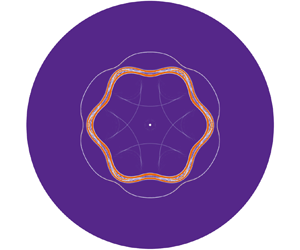Published online by Cambridge University Press: 10 August 2023

Instability evolutions of shock-accelerated thin cylindrical SF $_6$ layers surrounded by air with initial perturbations imposed only at the outer interface (i.e. the ‘Outer’ case) or at the inner interface (i.e. the ‘Inner’ case) are numerically and theoretically investigated. It is found that the instability evolution of a thin cylindrical heavy fluid layer not only involves the effects of Richtmyer–Meshkov instability, Rayleigh–Taylor stability/instability and compressibility coupled with the Bell–Plesset effect, which determine the instability evolution of the single cylindrical interface, but also strongly depends on the waves reverberated inside the layer, thin-shell correction and interface coupling effect. Specifically, the rarefaction wave inside the thin fluid layer accelerates the outer interface inward and induces the decompression effect for both the Outer and Inner cases, and the compression wave inside the fluid layer accelerates the inner interface inward and causes the decompression effect for the Outer case and compression effect for the Inner case. It is noted that the compressible Bell model excluding the compression/decompression effect of waves, thin-shell correction and interface coupling effect deviates significantly from the perturbation growth. To this end, an improved compressible Bell model is proposed, including three new terms to quantify the compression/decompression effect of waves, thin-shell correction and interface coupling effect, respectively. This improved model is verified by numerical results and successfully characterizes various effects that contribute to the perturbation growth of a shock-accelerated thin heavy fluid layer.
$_6$ layers surrounded by air with initial perturbations imposed only at the outer interface (i.e. the ‘Outer’ case) or at the inner interface (i.e. the ‘Inner’ case) are numerically and theoretically investigated. It is found that the instability evolution of a thin cylindrical heavy fluid layer not only involves the effects of Richtmyer–Meshkov instability, Rayleigh–Taylor stability/instability and compressibility coupled with the Bell–Plesset effect, which determine the instability evolution of the single cylindrical interface, but also strongly depends on the waves reverberated inside the layer, thin-shell correction and interface coupling effect. Specifically, the rarefaction wave inside the thin fluid layer accelerates the outer interface inward and induces the decompression effect for both the Outer and Inner cases, and the compression wave inside the fluid layer accelerates the inner interface inward and causes the decompression effect for the Outer case and compression effect for the Inner case. It is noted that the compressible Bell model excluding the compression/decompression effect of waves, thin-shell correction and interface coupling effect deviates significantly from the perturbation growth. To this end, an improved compressible Bell model is proposed, including three new terms to quantify the compression/decompression effect of waves, thin-shell correction and interface coupling effect, respectively. This improved model is verified by numerical results and successfully characterizes various effects that contribute to the perturbation growth of a shock-accelerated thin heavy fluid layer.